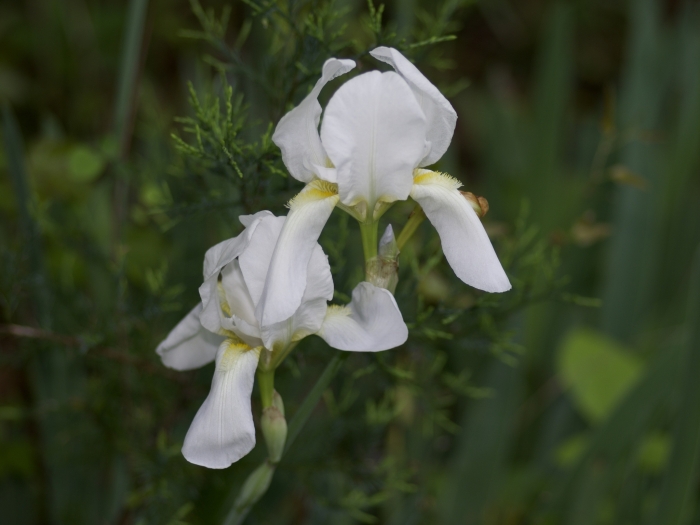White Flag Iris
(Iris albicans)
White Flag Iris (Iris albicans)
/
/

Michelle W.
CC BY 4.0
Image By:
Michelle W.
Recorded By:
Copyright:
CC BY 4.0
Copyright Notice:
Photo by: Michelle W. | License Type: CC BY 4.0 | License URL: http://creativecommons.org/licenses/by/4.0/ | Rights Holder: Michelle W. | Publisher: iNaturalist | Date Created: 2020-03-24T09:33:39-07:00 |




























Estimated Native Range
Summary
Iris albicans, commonly known as White Flag Iris, is an evergreen perennial herb with bulbous roots, originally found in graveyards and on rocky slopes in the Arabian Peninsula. It typically grows to 30–60 cm tall. The foliage consists of grey-green, broadly sword-shaped leaves that provide a striking architectural element to garden designs. The inflorescence is fan-shaped, bearing two or three fragrant flowers that emerge from grey or silvery buds. When in bloom, the flowers are pure white or off-white, each about 8 cm wide, and are known for their simplicity and elegance. As a sterile hybrid, White Flag Iris propagates through rhizomal growth and division rather than seed production, making it a historical plant with a long tradition in cultivation, possibly the oldest known cultivated iris.
White Flag Iris is valued for its drought tolerance, low maintenance, and the serene beauty of its white blooms, which can add a sense of tranquility to garden settings. It is often used in rock gardens, borders, and as an accent plant in xeriscaping. This iris thrives in full sun but can tolerate part shade, and it prefers well-drained soils. While generally disease-resistant, it can be susceptible to iris borer and root rot if conditions are too moist. Its historical significance and ease of division make it a favorite among gardeners who enjoy sharing plants.CC BY-SA 4.0
White Flag Iris is valued for its drought tolerance, low maintenance, and the serene beauty of its white blooms, which can add a sense of tranquility to garden settings. It is often used in rock gardens, borders, and as an accent plant in xeriscaping. This iris thrives in full sun but can tolerate part shade, and it prefers well-drained soils. While generally disease-resistant, it can be susceptible to iris borer and root rot if conditions are too moist. Its historical significance and ease of division make it a favorite among gardeners who enjoy sharing plants.CC BY-SA 4.0
Plant Description
- Plant Type: Bulb
- Height: 1-2 feet
- Width: 0.5-1.5 feet
- Growth Rate: Moderate
- Flower Color: White
- Flowering Season: Spring
- Leaf Retention: Evergreen
Growth Requirements
- Sun: Full Sun
- Water: Medium
- Drainage: Medium, Fast
Common Uses
Bee Garden, Bird Garden, Butterfly Garden, Deer Resistant, Fragrant, Hummingbird Garden, Low Maintenance, Rabbit Resistant, Rock Garden, Salt Tolerant, Showy Flowers, Street Planting
Natural Habitat
Originally found in graveyards and on rocky slopes in the Arabian Peninsula
Other Names
Common Names: Cemetery Iris, White Cemetery Iris, Kyrkogårdsiris
Scientific Names: , Iris albicans, Iris madonna, Iris albicans var. madonna, Iris albicans var. majoricensis, Iris florentina subsp. albicans, Iris florentina var. albicans, Iris florentina var. madonna, Iris germanica subsp. albicans, Iris majoricensis,
GBIF Accepted Name: Iris albicans Lange